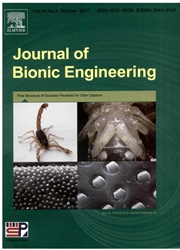

 中文摘要:
中文摘要:
Nonverbal and noncontact behaviors play a significant role in allowing service robots to structure their interactions withhumans.In this paper, a novel human-mimic mechanism of robot’s navigational skills was proposed for developing sociallyacceptable robotic etiquette.Based on the sociological and physiological concerns of interpersonal interactions in movement,several criteria in navigation were represented by constraints and incorporated into a unified probabilistic cost grid for safemotion planning and control, followed by an emphasis on the prediction of the human’s movement for adjusting the robot’spre-collision navigational strategy.The human motion prediction utilizes a clustering-based algorithm for modeling humans’indoor motion patterns as well as the combination of the long-term and short-term tendency prediction that takes into accountthe uncertainties of both velocity and heading direction.Both simulation and real-world experiments verified the effectivenessand reliability of the method to ensure human’s safety and comfort in navigation.A statistical user trials study was also given tovalidate the users’favorable views of the human-friendly navigational behavior.
 英文摘要:
英文摘要:
Nonverbal and noncontact behaviors play a significant role in allowing service robots to structure their interactions withhumans.In this paper, a novel human-mimic mechanism of robot’s navigational skills was proposed for developing sociallyacceptable robotic etiquette.Based on the sociological and physiological concerns of interpersonal interactions in movement,several criteria in navigation were represented by constraints and incorporated into a unified probabilistic cost grid for safemotion planning and control, followed by an emphasis on the prediction of the human’s movement for adjusting the robot’spre-collision navigational strategy.The human motion prediction utilizes a clustering-based algorithm for modeling humans’indoor motion patterns as well as the combination of the long-term and short-term tendency prediction that takes into accountthe uncertainties of both velocity and heading direction.Both simulation and real-world experiments verified the effectivenessand reliability of the method to ensure human’s safety and comfort in navigation.A statistical user trials study was also given tovalidate the users’favorable views of the human-friendly navigational behavior.
 同期刊论文项目
同期刊论文项目
 同项目期刊论文
同项目期刊论文
 Socially Acceptable Pre-collision Safety Strategies for Human-Compliant Navigation of Service Robots
Socially Acceptable Pre-collision Safety Strategies for Human-Compliant Navigation of Service Robots 期刊信息
期刊信息
